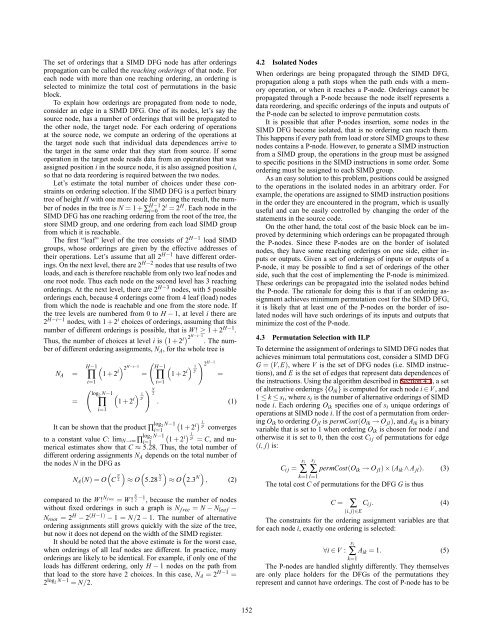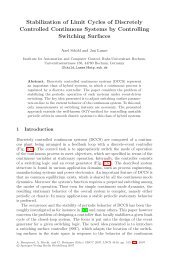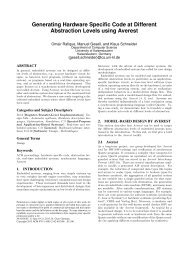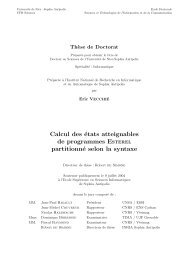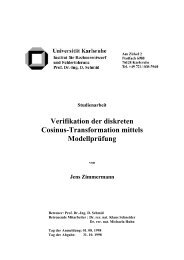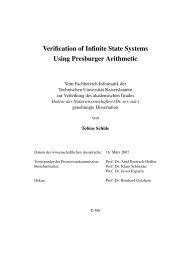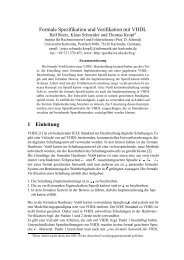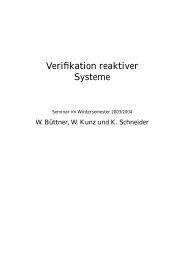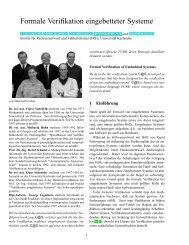Generation of permutations for {SIMD} processors - Embedded ...
Generation of permutations for {SIMD} processors - Embedded ...
Generation of permutations for {SIMD} processors - Embedded ...
Create successful ePaper yourself
Turn your PDF publications into a flip-book with our unique Google optimized e-Paper software.
The set <strong>of</strong> orderings that a <strong>SIMD</strong> DFG node has after orderings<br />
propagation can be called the reaching orderings <strong>of</strong> that node. For<br />
each node with more than one reaching ordering, an ordering is<br />
selected to minimize the total cost <strong>of</strong> <strong>permutations</strong> in the basic<br />
block.<br />
To explain how orderings are propagated from node to node,<br />
consider an edge in a <strong>SIMD</strong> DFG. One <strong>of</strong> its nodes, let’s say the<br />
source node, has a number <strong>of</strong> orderings that will be propagated to<br />
the other node, the target node. For each ordering <strong>of</strong> operations<br />
at the source node, we compute an ordering <strong>of</strong> the operations at<br />
the target node such that individual data dependences arrive to<br />
the target in the same order that they start from source. If some<br />
operation in the target node reads data from an operation that was<br />
assigned position i in the source node, it is also assigned position i,<br />
so that no data reordering is required between the two nodes.<br />
Let’s estimate the total number <strong>of</strong> choices under these constraints<br />
on ordering selection. If the <strong>SIMD</strong> DFG is a perfect binary<br />
tree <strong>of</strong> height H with one more node <strong>for</strong> storing the result, the number<br />
<strong>of</strong> nodes in the tree is N = 1 + ∑ H−1<br />
i=0 2i = 2 H . Each node in the<br />
<strong>SIMD</strong> DFG has one reaching ordering from the root <strong>of</strong> the tree, the<br />
store <strong>SIMD</strong> group, and one ordering from each load <strong>SIMD</strong> group<br />
from which it is reachable.<br />
The first “leaf” level <strong>of</strong> the tree consists <strong>of</strong> 2 H−1 load <strong>SIMD</strong><br />
groups, whose orderings are given by the effective addresses <strong>of</strong><br />
their operations. Let’s assume that all 2 H−1 have different orderings.<br />
On the next level, there are 2 H−2 nodes that use results <strong>of</strong> two<br />
loads, and each is there<strong>for</strong>e reachable from only two leaf nodes and<br />
one root node. Thus each node on the second level has 3 reaching<br />
orderings. At the next level, there are 2 H−3 nodes, with 5 possible<br />
orderings each, because 4 orderings come from 4 leaf (load) nodes<br />
from which the node is reachable and one from the store node. If<br />
the tree levels are numbered from 0 to H − 1, at level i there are<br />
2 H−i−1 nodes, with 1 + 2 i choices <strong>of</strong> orderings, assuming that this<br />
number <strong>of</strong> different orderings is possible, that is W! ≥ 1 + 2 H−1 .<br />
Thus, the number <strong>of</strong> choices at level i is ( 1 + 2 i) 2 H−i−1 . The number<br />
<strong>of</strong> different ordering assignments, N A , <strong>for</strong> the whole tree is<br />
N A =<br />
=<br />
H−1(<br />
∏ 1 + 2 i) 2 H−i−1 =<br />
i=1<br />
( ) H−1 (<br />
2 H−1<br />
∏ 1 + 2 i) 1 2 i =<br />
i=1<br />
( ) N<br />
log2 N−1(<br />
∏ 1 + 2 i) 1 2<br />
2 i . (1)<br />
i=1<br />
It can be shown that the product ∏ log 2 N−1 (<br />
i=1 1 + 2 i ) 1 2 i converges<br />
to a constant value C: lim N→∞ ∏ log 2 N−1 (<br />
i=1 1 + 2 i ) 1 2 i = C, and numerical<br />
estimates show that C ≈ 5.28. Thus, the total number <strong>of</strong><br />
different ordering assignments N A depends on the total number <strong>of</strong><br />
the nodes N in the DFG as<br />
( ) ( ) (<br />
N A (N) = O C N 2 ≈ O 5.28 N 2 ≈ O 2.3 N) , (2)<br />
compared to the W! N f ree<br />
= W! N 2 −1 , because the number <strong>of</strong> nodes<br />
without fixed orderings in such a graph is N f ree = N − N lea f −<br />
N root = 2 H − 2 (H−1) − 1 = N/2 − 1. The number <strong>of</strong> alternative<br />
ordering assignments still grows quickly with the size <strong>of</strong> the tree,<br />
but now it does not depend on the width <strong>of</strong> the <strong>SIMD</strong> register.<br />
It should be noted that the above estimate is <strong>for</strong> the worst case,<br />
when orderings <strong>of</strong> all leaf nodes are different. In practice, many<br />
orderings are likely to be identical. For example, if only one <strong>of</strong> the<br />
loads has different ordering, only H − 1 nodes on the path from<br />
that load to the store have 2 choices. In this case, N A = 2 H−1 =<br />
2 log 2 N−1 = N/2.<br />
4.2 Isolated Nodes<br />
When orderings are being propagated through the <strong>SIMD</strong> DFG,<br />
propagation along a path stops when the path ends with a memory<br />
operation, or when it reaches a P-node. Orderings cannot be<br />
propagated through a P-node because the node itself represents a<br />
data reordering, and specific orderings <strong>of</strong> the inputs and outputs <strong>of</strong><br />
the P-node can be selected to improve permutation costs.<br />
It is possible that after P-nodes insertion, some nodes in the<br />
<strong>SIMD</strong> DFG become isolated, that is no ordering can reach them.<br />
This happens if every path from load or store <strong>SIMD</strong> groups to these<br />
nodes contains a P-node. However, to generate a <strong>SIMD</strong> instruction<br />
from a <strong>SIMD</strong> group, the operations in the group must be assigned<br />
to specific positions in the <strong>SIMD</strong> instructions in some order. Some<br />
ordering must be assigned to each <strong>SIMD</strong> group.<br />
As an easy solution to this problem, positions could be assigned<br />
to the operations in the isolated nodes in an arbitrary order. For<br />
example, the operations are assigned to <strong>SIMD</strong> instruction positions<br />
in the order they are encountered in the program, which is usually<br />
useful and can be easily controlled by changing the order <strong>of</strong> the<br />
statements in the source code.<br />
On the other hand, the total cost <strong>of</strong> the basic block can be improved<br />
by determining which orderings can be propagated through<br />
the P-nodes. Since these P-nodes are on the border <strong>of</strong> isolated<br />
nodes, they have some reaching orderings on one side, either inputs<br />
or outputs. Given a set <strong>of</strong> orderings <strong>of</strong> inputs or outputs <strong>of</strong> a<br />
P-node, it may be possible to find a set <strong>of</strong> orderings <strong>of</strong> the other<br />
side, such that the cost <strong>of</strong> implementing the P-node is minimized.<br />
These orderings can be propagated into the isolated nodes behind<br />
the P-node. The rationale <strong>for</strong> doing this is that if an ordering assignment<br />
achieves minimum permutation cost <strong>for</strong> the <strong>SIMD</strong> DFG,<br />
it is likely that at least one <strong>of</strong> the P-nodes on the border <strong>of</strong> isolated<br />
nodes will have such orderings <strong>of</strong> its inputs and outputs that<br />
minimize the cost <strong>of</strong> the P-node.<br />
4.3 Permutation Selection with ILP<br />
To determine the assignment <strong>of</strong> orderings to <strong>SIMD</strong> DFG nodes that<br />
achieves minimum total <strong>permutations</strong> cost, consider a <strong>SIMD</strong> DFG<br />
G = (V,E), where V is the set <strong>of</strong> DFG nodes (i.e. <strong>SIMD</strong> instructions),<br />
and E is the set <strong>of</strong> edges that represent data dependences <strong>of</strong><br />
the instructions. Using the algorithm described in Section 4.1, a set<br />
<strong>of</strong> alternative orderings {O ik } is computed <strong>for</strong> each node i ∈ V , and<br />
1 ≤ k ≤ s i , where s i is the number <strong>of</strong> alternative orderings <strong>of</strong> <strong>SIMD</strong><br />
node i. Each ordering O ik specifies one <strong>of</strong> s i unique orderings <strong>of</strong><br />
operations at <strong>SIMD</strong> node i. If the cost <strong>of</strong> a permutation from ordering<br />
O ik to ordering O jl is permCost(O ik → O jl ), and A ik is a binary<br />
variable that is set to 1 when ordering O ik is chosen <strong>for</strong> node i and<br />
otherwise it is set to 0, then the cost C i j <strong>of</strong> <strong>permutations</strong> <strong>for</strong> edge<br />
(i, j) is:<br />
s i<br />
s j<br />
∑ ∑<br />
C i j = permCost(O ik → O jl ) × (A ik ∧ A jl ). (3)<br />
k=1 l=1<br />
The total cost C <strong>of</strong> <strong>permutations</strong> <strong>for</strong> the DFG G is thus<br />
∑<br />
C = C i j . (4)<br />
(i, j)∈E<br />
The constraints <strong>for</strong> the ordering assignment variables are that<br />
<strong>for</strong> each node i, exactly one ordering is selected:<br />
s i<br />
∑<br />
∀i ∈ V : A ik = 1. (5)<br />
k=1<br />
The P-nodes are handled slightly differently. They themselves<br />
are only place holders <strong>for</strong> the DFGs <strong>of</strong> the <strong>permutations</strong> they<br />
represent and cannot have orderings. The cost <strong>of</strong> P-node has to be<br />
LCTES’05, 6 2005/4/16<br />
152


